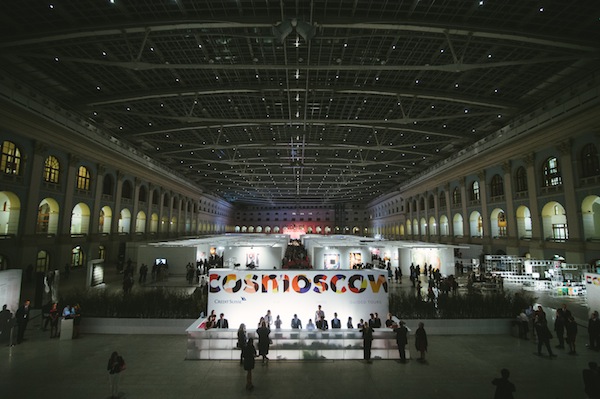Art Fairs
Cosmoscow Fights for a Russian Contemporary Art Market
The only international art fair in Russia brings together a burgeoning regional scene.

The only international art fair in Russia brings together a burgeoning regional scene.

Alyssa Buffenstein

The Kremlin might not be a fan of contemporary art, but just across the Red Square, Cosmoscow fights for young art in a big way. The Gostiny Dvor, a grand exhibition hall, houses the fair for the second year, from September 9-11. Lined in neoclassical arches and columns, and topped with a glass ceiling, the setting makes for a lavish scene that gives an air of importance to the emerging galleries and affordable works that fill the space.
Appealing to a new, young generation of Russian collectors, Cosmoscow—the only international contemporary art fair in Russia and the Commonwealth of Independent States—is a key player in the effort to bring Russia into the international dialogue of contemporary art, no matter what the government has to say about it.
Russia’s Minister of Culture Vladimir Medinsky is known for his outspoken stance against modern and contemporary art, especially in international traditions. Until recently, collectors of contemporary art in Moscow felt like they were part of an exclusive club. But the opening of more and more institutions dedicated to Modern and contemporary art in the city center speaks to the growing interest from collectors, investors, and art lovers. Last year, the Garage Museum opened its Rem Koolhaas-designed doors, and the V-A-C, a foundation dedicated to contemporary art and culture, is currently building a new headquarters nearby, designed by Renzo Piano.
Realted: Garage Museum To Inaugurate First Russian Art Triennial in 2017
Director and founder of Cosmoscow, Margarita Pushkina, is especially keen on supporting young Russian talent. At the press conference and VIP opening, she was even proud to say that her outfit was created by Ruban, a Moscow-based couture brand launched in 2010. The fair reflects this spirit, with the majority of galleries based in Moscow, and representing Russian artists.

Works by Ilya Dolgov at HLAM Gallery’s booth.
Just 38 galleries occupy the orderly square booths, and 18 comprise the “discovery” section, dedicated to galleries that are less than five years old and represent emerging artists. Despite the relatively small number, it’s a record size for Cosmoscow. Of the 38, 31 are based in Russia, and 25 in Moscow. Four come from St. Petersburg, which is reputed to be the more experimental and underground of Russia’s two largest cities. TNN gallery is based in Tbilisi, Georgia, and they claim to be the sole Georgian gallery that works internationally. Besides One Gallery, which is a gallery forged from two previously-existing galleries in New York and Sofia, Bulgaria, there are no galleries from the Americas. There are none from Asia or the Middle East either, and only a few from Europe: One gallery came from Belgium, another from Spain, and two from London.
The international galleries all already have strong ties to, and a network of contacts in, Russia. NK Gallery is based in Antwerp, Belgium, but its director, Nadya Kotova-Maesen, is Russian. She believes that “culture is an international language,” and is interested in pushing dialogue between countries. She’s showing works by two artists, the Russian Taisia Korotkova, and the Belgian Hans Vandekerckhove. Korotkova, winner of the Kandinsky prize in 2010, paints muted canvasses of futuristic subjects inspired by science and technology, while Vandekerckhove’s paintings in the booth were inspired by Olafur Eliasson’s Your Rainbow Panorama at the ARoS Art Museum in Aarhus, Denmark. The paintings are priced between €6,000 and €8,000, and NK’s collectors, Kotova-Maesen says, are generally based in Europe, but usually have some sort of connection to Russia, like family history or marriage.

Works by Kirill Chelushkin and Dmitri Tsykalov at Marina Gisich.
A large amount of galleries’ price points clocked in at under €10,000, and some works were shockingly inexpensive for someone used to prices at a more longstanding fair in a city like London or New York. Artist Ilya Dolgov, represented by HLAM Gallery, was one winner of the Credit Suisse Cosmoscow Art Prize for Young Artists, a €3,000 prize awarded to three artists (besides Dolgov, Anastasia Bogomolova and Anastasia Kuzmina won as well). Dolgov’s intricate botanical drawings go for just €1,100. Some international visitors even said they encouraged their friends who may be new to collecting to come to Cosmoscow to test the waters of buying art.
Sales for this emerging market seemed promising, from modestly-priced works to mid-range, and even the one anomalous gallery selling works upwards of €100,000. Before the fair even opened for VIPs, Marina Gisich Gallery had already made a sale; a piece from Dimitri Tsykalov’s “Skin” series, animal skin trophies made of military ammunition boxes that the artist bought on online auctions. The works were priced around €38,000. And Art4, a museum and auction platform, had some grayish, figurative paintings on view—and sale—through their platform, from €14,000 to €110,000.

Works by Olga Bozhko at Galerie Iragui’s booth.
On Friday morning, Galerie Iragui, a buzzing young gallery, had a few sales in the works. They showed what may have been the most exciting and memorable works of the fair: Olga Bozhko’s knitted brick walls, were “graffitied” with English words in yarn: “fuck,” “peace,” and “true.” Each was then given a Russian language ending, so that they took on new meanings when pronounced by a Russian speaker. “True,” for example, plus a few Cyrillic characters, took on the meaning of “corpse.”
Building a market and strengthening a community around contemporary art is hard work and takes time, but it seems like Moscow is off to a promising start, and Cosmoscow’s passionate team is dedicated to steering it in the right direction. As of yet, the next big art star doesn’t seem to be coming from Russia, but perhaps the fair could help to support an environment where they could. For young collectors and those curious about more than just the big names, Cosmoscow should stay on the radar.